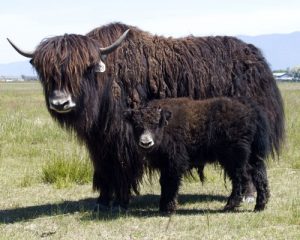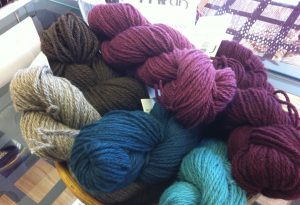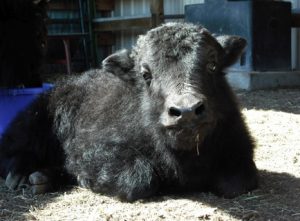So many fibers. And all with a story. Cotton, of course, so cozy, so comfortable but burdened by its history of human suffering. Silk, made by worms, luminescent, beloved by royalty for thousands of years. Wool. Europeans and sheep breeders all over the world have worked to make wool that sits like gossamer on our skin. They succeeded too. But you have to pay the price. There is no forgetting the ubiquitous acrylics and polyesters. They are petroleum based, made from trees and plants that sank into the earth millions of years ago and with time, compression and heat produced the black gold that powers our lives. The venerable linen, made from flax, a plant that was spun, dyed and knotted by humans living in Southern Russia 30,000 years ago. That is not a typo; apparently even 30 millennia into the past, humans have wanted cute things to wear. http://www.npr.org/templates/story/story.php?storyId=112726804
 There is Angora from rabbits, cashmere from goats, but today’s story is about fiber from the Yak.
There is Angora from rabbits, cashmere from goats, but today’s story is about fiber from the Yak.
Yaks are beautiful animals, important to the nomadic herders of Tibet producing the majority of their needs as did the Buffalo for the Native Americans. Only recently, the soft undercoat shed by baby Yaks was discovered to be a source of high-end fiber now made into clothing, bedding and yarns.
Italian fiber artist, Paola Vanzo spent 20 years working with the nomadic herders of the Tibet. She and her company use small artisan mills in Italy to process the Yak fibers from Tibet. https://myak.it Paola’s yarn, pictured  here, is available at a wonderful Texas yarn shop where all products are highly curated—meaning sourced from suppliers who care about water, animals and the human beings who originate the fibers used. http://www.thesatedsheep.com.
here, is available at a wonderful Texas yarn shop where all products are highly curated—meaning sourced from suppliers who care about water, animals and the human beings who originate the fibers used. http://www.thesatedsheep.com.
The Tibetan herders are paid much-needed cash for the fibers shed by the baby Yaks and Paolo believes she is helping build a future for one of the world’s most ancient ways of life. The Yaks currently supply their human herders with very rich milk, horn, hair for tents, ropes, rugs and meat said to be of incomparable quality. As my readers may know, I believe domesticated animals adopted humans and not the other way around. The Covenant of the Wild, Why Animals Chose Domestication, Stephen Budiansky. I assume a Yak would have no better luck surviving the wild plains of Tibet than my little cow would have if she were loosed to fend for herself. But such an extreme interdependence between one animal and humans is hard to picture–for one’s life to revolve around one thing and to use every part of that thing is waste management at its zenith. Paola finds that after processing the baby Yak hair in Italy, she has a high percentage of waste product. She sends it back to Tibet. The Tibetans use it to stuff mattresses.
How would we even begin. To use everything we have, then use the waste.

So interesting!! I must get to the sated sheep shop soon. Say that three times quickly. Ha!
It sounds like the Tibetans are blessed to have Paola Vanzo as a friend.